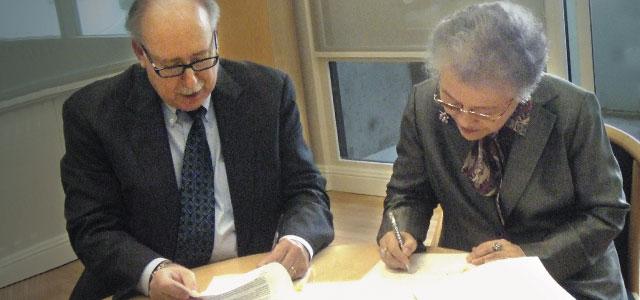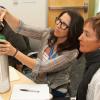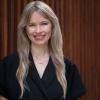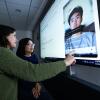
Dean David Vlahov (left) with Hiroko Minami
Nursing in Disasters
When the devastating earthquake and tsunami hit northeast Japan in March 2011 – killing almost 16,000 people, injuring thousands more and setting off a perilous nuclear release – a unique group of nurses promised themselves, their nation and the world that their ability to respond to such disasters would get better.
They have a plan.
Specifically, these nurses, professors and department heads from five Japanese nursing schools are launching a first-of-its kind PhD program in disaster nursing, with the goal of training global nurse leaders in disaster response.
Leading the effort is Hiroko Minami, president of the University of Kochi and a 1982 doctoral graduate of UCSF School of Nursing. She and her team were at her alma mater recently, meeting with School of Nursing Dean David Vlahov and key faculty in hopes of forging an academic collaboration on the new program.
“This program is necessary and timely,” says Vlahov. “Care for people affected by natural and man-made disasters has been understudied, and we all want to know the most effective means by which we can assist people in recovery.”
Idea Rooted in Earlier Japanese Earthquake
This new program is called the Disaster Nursing Global Leader Degree Program, and its vision is rooted in the 1995 Kobe, or “Great Hanshin,” earthquake, which killed more than 6,000, injuring scores more.
Minami – who was then president at the University of Hyogo, located in Kobe – says that while she wasn’t physically hurt in the event, the emotional impact of being at the epicenter was powerful and lingering. The earthquake impacted the lives of several students and staff and faculty members – and while the campus suffered only minor damage, it was a hive of emergency nursing care.
The University of Hyogo College of Nursing Art and Science quickly established a nursing network to help, which eventually led Minami to establish the Japan Society of Disaster Nursing.
A new specialty took wing. “Before this, there was a word for nursing and a word for disaster, but no word for disaster nursing,” Minami explains.
Despite this proactive response, some College of Nursing faculty members continued to experience a kind of post-traumatic stress, even years after the quake. They found themselves questioning whether their response was adequate, says Minami. There was disagreement and discomfort.
But the tension also led to a national and then global conversation on disaster response, made fervent by each new incident: The sarin gas attack in the Tokyo subway. The Indonesian tsunami. Earthquakes in Haiti, China and Chile. The terrorist attacks of 9/11 in the US. And Japan’s quake of March 11, 2011, with its frightening reminder of unpredictable results.
With each new event, Minami and the other nurse leaders behind the new program felt certain they were on the right path.
Five Schools, Rotating Students
In addition to the University of Kochi, the other schools involved in the program are the University of Hyogo, the Japanese Red Cross College of Nursing, Chiba University and Tokyo Medical and Dental University – a deliberate mix of private and public, state and national.
“This is a very new kind of program; very, very new to the minister of education, and he is very, very happy to have us,” says Minako Morita, a professor at the Japanese Red Cross College of Nursing.
The five-year program, which will offer only a PhD, is designed for those with a BS in nursing. Students will take courses at all schools, through online and physical instruction, depending on where they live. The interdisciplinary curriculum is designed to hone researchers as well as policy experts and managers. Courses include research methods, statistics and epidemiology, organizational leadership, ethics and clinical skills. Students will also complete internships in a variety of settings.
“We are dreaming of our graduates becoming leaders in the United Nations, at NGO organizations – and also clinical practice leaders,” says Morita.
Harnessing the Skills of Nurses
“Nurses are positioned to play a leadership role in disaster response, because we do care and cure,” says Minami. That is, in addition to providing emergency treatment or cures, nurses also serve as primary providers for people struggling with the long-term effects of disasters, including those without homes, water and food. It’s part of a nurse’s training to care for the whole person, including addressing patient needs in a broad social context that includes housing, nutrition and income.
Morita and her teams did just that while providing emergency response after the March 11 disaster, but their work didn’t end there.
“I interviewed people who had to be evacuated and relocated,” she says. “They suffered the tsunami and the big nuclear exposure; and then on top of that they were discriminated against when they relocated to nonaffected areas because of their radiation exposure – and they suffered financial damages. When I saw them firsthand, I thought, ‘This is exactly where nursing is needed – initially and for a long time.’”
“We definitely have a bowl full of knowledge that can be used around the world,” Minami says. “We’d like to make a consortium with all the nursing experts in this field, and collaborate with universities all over the world.”
Common Personal, Professional Bonds
While they questioned the logistical challenge of involving five campuses and the practicality of providing only a PhD option, Vlahov and other UCSF nursing faculty meeting with the Japanese team generally embraced the concept of collaboration, clearly seeing the potential for faculty and student exchanges or shared research.
“We have had long-standing relations with our colleagues in Japan and are delighted to share this focus,” says Vlahov, who last year signed a memorandum of understanding with Minami, setting the stage for UCSF collaboration on the graduate training concept.
“We share the Pacific Rim, where the risk of natural disasters is present, and we can learn from each other,” he continues. “The experience in Japan during the past few years provides important lessons for us all – and our joint research and education will strengthen the field of disaster nursing.”
The concept has personal significance to Vlahov, as well as to his wife, Robyn Gershon, a professor of epidemiology and biostatistics at UCSF’s Philip R. Lee Institute for Health Policy Studies.
They lived in New York on 9/11 and, while grieving personally, immediately turned their professional focus to the attack. Vlahov, then director of the Center for Urban Epidemiologic Studies at the New York Academy of Medicine, led a major mental health assessment and follow-up of New York City residents, finding that support fell drastically short of need.
Gershon, who was then a professor at Columbia’s Mailman School of Public Health, was the principal investigator of the World Trade Center Disaster Study, a government-funded analysis of building design and codes, which led to far-reaching recommendations for emergency preparedness, especially in urban settings.
Warm Welcome in Earthquake Country
While many organizations and agencies are working on disaster response, the Japanese nursing doctorate sets a new standard, Gershon says – and she makes a prediction.
“There are very few disaster nursing programs anywhere. Nothing that I am aware of even approximates this innovative program, which is designed to intensively prepare doctoral-level disaster nursing specialists and leaders,” she says. “It will quickly set a new international standard in the field.”
Sally Rankin, the School’s associate dean for global health, adds, “The need for cooperation amongst countries in times of disasters is paramount, and the ability to intervene through specially educated nursing groups is an effective approach. US nursing has a lot to learn from the experiences of our Japanese colleagues. Cooperation on this educational project can benefit us and may help establish an international cadre of well-trained and prepared nurses.”



